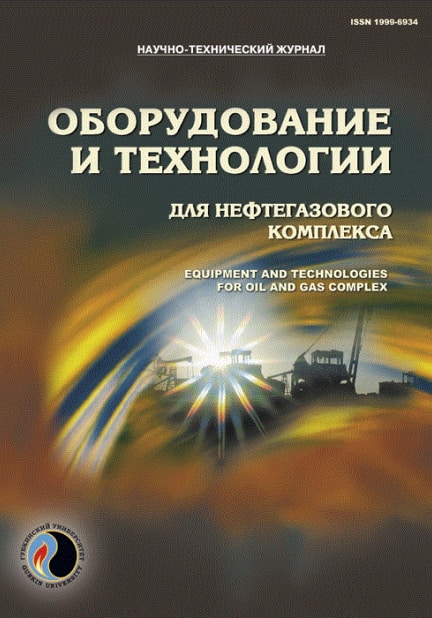Scientific and technical journal
«Equipment and technologies for oil and gas complex»
ISSN 1999-6934

Assessment of gas wells initial production based on neural network
UDC: 622.276:519.85
DOI: -
Authors:
1 Orenburg State University, Orenburg, Russia
2 Modeling and Monitoring of Geological Objects Named after V.A. Dvurechensky, Moscow, Russia
3 National University of Oil and Gas "Gubkin University", Moscow, Russia
Keywords: algorithm, gas-hydrodynamic studies, gas well flow rate, methodology, neural network, training
Annotation:
The authors of the article propose a methodology for estimating the flow rate of gas wells to be put into operation in a deposit that already has a group of operating production wells. The methodology is based on the use of a neural network, the construction of which uses data on the operation and design of operating wells. The algorithms for constructing a neural network and examples of its application are given. The results obtained suggest a higher accuracy of flow rate estimation based on a neural network, compared to the use of gas-hydrodynamic studies of wells to determine flow rate. Correct application of the proposed methodology is possible if there is a volume of field data sufficient to form a training sample and subsequent construction of a neural network, which makes it possible to determine the initial flow rate of a well without conducting gas-hydrodynamic studies of the well being put into operation.
Bibliography:
1. Rukovodstvo po issledovaniyu skvazhin / A.I. Gritsenko, Z.S. Aliev, O.M. Ermilov [i dr.]. – M.: Nauka, 1995. – 523 s.2. Prakticheskaya netselesoobraznost' i nevozmozhnost' issledovaniya gorizontal'nykh gazovykh skvazhin na statsionarnykh rezhimakh fil'tratsii / Z.S. Aliev, D.A. Marakov, V.N. Kotlyarov, L.V. Samuylova // Gazovaya prom-st'. – 2014. – № 1(701). – S. 44–48.
3. Pribory, oborudovanie, metodika gazogidrodinamicheskikh raschetov pokazateley, ispol'zuemykh na stadii poiskovo-razvedochnykh rabot. Ch. 1: ucheb.-metod. posobie po kursu "Stroitel'stvo skvazhin" / Yu.V. Volkov, S.E. Valeeva, R.A. Mudarisova, M.R. Fatkulin. – Kazan': Kazanskiy un-t, 2018. – 75 s.
4. Shamsiev M.N., Gadil'shina V.R. Interpretatsiya rezul'tatov gazogidrodinamicheskikh issledovaniy vertikal'nykh skvazhin v gazovykh plastakh // Geologiya, geofizika i razrabotka neftyanykh i gazovykh mestorozhdeniy. – 2024. – № 4(388). – S. 70–72.
5. Upravlenie dobychey nefti na osnove neyrosetevoy optimizatsii rezhimov raboty skvazhin na uchastke opytno-promyshlennykh rabot plasta YuV1 Vat'eganskogo mestorozhdeniya TPP "Povkhneftegaz" / L.S. Brilliant, M.R. Dulkarnaev, M.Yu. Dan'ko [i dr.] // Georesursy. – 2022. – T. 24, № 1. – S. 3–15. – DOI: 10.18599/grs.2022.1.1
6. Prognozirovanie dinamiki izmeneniya debita nefti s pomoshch'yu metodov mashinnogo obucheniya / G.G. Fayzrakhmanov, I.I. Khayrullin, R.R. Khasanov [i dr.] // Neftyanaya provintsiya. – 2023. – № 3(35). – S. 73–83. – DOI: 10.25689/NP.2023.3.73-83
7. Bahaloo S., Mehrizadeh M., Najafi-Marghmaleki A. Review of application of artificial intelligence techniques in petroleum operations // Petroleum Research. – 2023. – Vol. 8, Issue 2. – P. 167–182. – DOI: 10.1016/j.ptlrs.2022.07.002
8. A new approach in well placement optimization using metaheuristic algorithms / S. Raji, A. Dehnamaki, B. Somee, M.R. Mahdiani // J. of Petroleum Science and Engineering. – 2022. – Vol. 215, Part A. – P. 110640. – DOI: 10.1016/j.petrol. 2022.110640
9. Prediction of fold-of-increase in productivity index post limited entry fracturing using artificial neural network / S.G. Ramah, M.A. Othman, A.Z. Nouh, T. El-Kwidy // Petroleum Research. – 2022. – Vol. 7, Issue 2. – P. 236–245. – DOI: 10.1016/j.ptlrs.2021.09.002
10. A production prediction method of single well in water flooding oilfield based on integrated temporal convolutional network model / Zhang Lei, Dou Hongen, Wang Tianzhi [et al.] // Petroleum Exploration and Development. – 2022. – Vol. 49, Issue 5. – P. 1150–1160. – DOI: 10.1016/S1876-3804(22)60339-2
11. Zakharov L.A., Martyushev D.A., Ponomareva I.N. Predicting dynamic formation pressure using artificial intelligence methods // J. of Mining Institute. – 2022. – Vol. 253. – P. 23–32. – DOI: 10.31897/PMI.2022.11
12. Automatic well test interpretation based on convolutional neural network for a radial composite reservoir / Li Daolun, Liu Xuliang, Zha Wenshu [et al.] // Petroleum Exploration and Development. – 2020. – Vol. 47, Issue 3. – P. 623–631. – DOI: 10.1016/S1876-3804(20)60079-9
13. Ivakhnenko A.G. Nepreryvnost' i diskretnost'. – Kiev: Naukova dumka, 1990. – 224 s.
14. Objective Choice of Optimal Clustering of Data Sampling under Nonrobust Random Disturbances Compensation / A.G. Ivakhnenko, S.A. Petuchova [et al.] // Soviet J. of Automation and Information Sciences. – 1993. – Vol. 26, No. 4. – P. 58–65.
15. Ivakhnenko A.G., Ivakhnenko G.A. Perceptron Synthesis under Balance of Clusterisation Criterion // Pattern Recognition and Image Analysis. – 1995. – Vol. 5, No. 3.
16. Ivakhnenko A.G., Ivakhnenko G.A., Muller J.A. Self-Organization of Neuronets with Active Neurons // Pattern Recognition and Image Analysis. – 1994. – Vol. 4, No. 4. – P. 177–188.
17. Ivakhnenko A.G. Self-Organization of Neuronet with Active Neurons for Effects of Nuclear Test Explosions Forecastings // System Analysis Modeling Simulation. – 1995. – Vol. 20. – P. 107–116.
18. Zholnarsky A.A. Agglomerative Cluster Analysis Procedures for Multidimensional Objects: A Test for Convergence // Pattern Recognition and Image Analysis. – 1992. – Vol. 25, No. 4. – P. 389–390.